|
MR Safety
|
Exhibition Hall 17:00 - 18:00 |
|
|
|
Computer # |
|
3644.
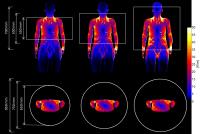 |
73 |
DEVELOPMENT OF A SET OF GENERIC NUMERICAL BIRDCAGES FOR
COMPREHENSIVE EVALUATIONS OF INDUCED RF FIELDS FOR IMPLANT
SAFETY - Permission Withheld
Eugenia Cabot1, Earl Zastrow1,2, and
Niels Kuster1,2
1IT'IS Foundation, Zurich, Switzerland, 2ETHZ,
Zurich, Switzerland
A study of in
vivo radiofrequency
exposure of a group of human models to a reduced set of
birdcages that cover clinical scanner variability was
performed at 64 MHz, with a view to the assessment of
implant safety during magnetic resonance imaging.
Finite-difference time-domain simulations were run for
combinations of human model/landmark/birdcage for quadrature
fed coils representing closed-bore systems with respect to
RF exposure. The evaluation of the E-fields for the Tier 3
of TS109741 shows
large variations in the tangential E-field values obtained
with the different coils.
|
|
3645.
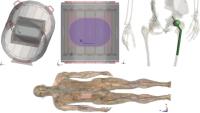 |
74 |
Uncertainty of RF Induced Heating Tests of a Generic Orthopedic
Implant in Different Phantoms 
Mahdi Abbasi1,2, Yacine Noureddine1,
Gregor Schaefers1,3, and Daniel Erni2
1MR:comp GmbH, Gelsenkirchen, Germany, 2Faculty
of Engineering/ATE, Duisburg-Essen University, Duisburg,
Germany, 3MRI-STaR
GmbH, Gelsenkirchen, Germany
comparison study has been implemented for a generic
orthopedic implant (GOI) in ASTM and Elliptical phantom as
well as in homogeneous and heterogeneous Duke model in terms
of RF induced heating to evaluate the uncertainty of RF
induced heating tests in phantoms. The parameters to be
evaluated to track the hotspots at the surrounding tissue of
the GOI were assessed.
|
|
3646.
 |
75 |
Decoupling a prosthetic hip implant from a parallel transmit
array using different numbers of transmit channels 
Arian Beqiri1, Joseph V Hajnal1,2, and
Shaihan J Malik1
1Imaging Sciences and Biomedical Engineering,
King's College London, London, United Kingdom, 2Centre
for the Developing Brain, King's College London, London,
United Kingdom
Ensuring safe imaging around metallic implants is paramount
to safety in MRI. Parallel transmission offers the
possibility of electromagnetically decoupling metallic
implants from an RF coil. Here the impact of the number of
transmit channels used is assessed in terms of reduction of
SAR around the implant and improvement in the homogeneity of
the B1+ imaging
field.
|
|
3647.
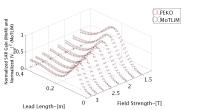 |
76 |
The Effect of Field Strength on Wire-tip Heating: Simulation and
Direct Measurements at 1.5T and 3T 
Volkan Acikel1 and
Daniel B Ennis1,2
1Department of Radiological Sciences, University
of California Los Angeles, Los Angeles, CA, United States, 2Department
of Bioengineering, University of California Los Angeles, Los
Angeles, CA, United States
MRI presents several potential risks for patients with
implanted devices and one of the main concerns is RF induced
heating of devices and nearby tissues. The aim of this
study was to compare the RF induced heating characteristic
of wires at 1.5T and 3T using simulations and direct
measurements. Greater heating (SAR amplification) can be
observed at lower field strengths for longer wires.
|
|
3648.
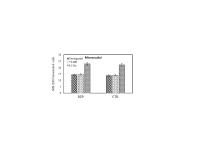 |
77 |
Genetic damage investigations after repeated exposures to 7 T
Magnetic Resonance Imaging 
Mahsa Fatahi1, Annika Reddig2,
Vijayalaxmi Vijayalaxmi3, Bjoern Friebe4,
Dirk Roggenbuck 5,6,
Dirk Reinhold2, and Oliver Speck1,7,8,9
1Biomedical Magnetic Resonance,
Otto-von-Guericke-University Magdeburg, Magdeburg, Germany, 2Institute
of Molecular and Clinical Immunology,
Otto-von-Guericke-University Magdeburg, Magdeburg, Germany, 3Department
of Radiology, University of Texas Health Science Center, San
Antonio, TX, United States, 4Department
of Radiology and Nuclear Medicine,
Otto-von-Guericke-University Magdeburg, Magdeburg, Germany, 5Faculty
of Natural Sciences, Brandenburg University of Technology
Cottbus-Senftenberg, Senftenberg, Germany, 6Medipan
GmbH, Dahlewitz/Berlin, Berlin, Germany, 7Leibniz
Institute for Neurobiology, Magdeburg, Germany, 8Center
for Behavioral Brain Sciences, Magdeburg, Germany, 9German
Center for Neurodegenerative Disease, Magdeburg, Germany
Synopsis. Ultra-high field magnetic
resonance imaging (UHF MRI) is a technological development
which is now only used for research purpose. Healthy
individuals working with UHF MRI scanners as well as those
participating in research investigations are repeatedly
exposed to high field strengths, which can be >2-fold
greater than those regularly used in clinics. In this study,
we have examined the extent of genetic damage in peripheral
blood mononuclear cells (PBMC) obtained from such
individuals exposed to 7T MRI.
|
|
3649.
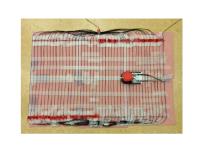 |
78 |
Large volume distributed temperature measurements using
MRI-compatible Raman spectroscopy 
Paul de Bruin1, Wouter Teeuwisse1,
Andrew Webb1, and Rolf Hut2
1Leiden University Medical Centre, Leiden,
Netherlands, 2Technical
University Delft, Delft, Netherlands
A new method of monitoring temperature non-invasively within
an MRI scanner is introduced. This method is based on Raman
backscattering, with the sensor consisting of a long length
of thin optical fibre which can be arranged in any desired
geometry. The major advantage over existing techniques is
that a wide area of surface temperatures can be monitored
simultaneously. Preliminary feasibility of the approach is
shown here for localized and global temperature
measurements.
|
|
3650.
 |
79 |
Accurate and precise dynamic contrast enhanced (DCE)
measurements with reduced gadolinium toxicity by lengthening
pre-injection baseline 
Samuel Barnes1, Thomas Ng2, and
Russell Jacobs3
1Radiology, Loma Linda University Medical Center,
Loma Linda, CA, United States, 2Radiology,
Brigham and Women's Hospital, Boston, MA, United States, 3Caltech,
Pasadena, CA, United States
For increased patient safety it is desirable to acquire
dynamic contrast enhanced (DCE) MRI data with the lowest
passable Gd contrast agent (CA) dose. However, a lower CA
dose generally leads to smaller signal changes and lower
quality studies. Through simulations we show that lower CA
doses (up to 1/2 dose) can be compensated for by extending
the pre-injection baseline acquisition time to maintain
similar accuracy and precision of the fitted Ktrans values.
|
|
3651.
|
80 |
Effect of Renal Function on T1 signal changes in deep brain
nuclei - Video Not Available
Yan Cao1, Yang Zhang1,2, George Shih1,
Yan Zhang1, and Martin R Prince1,3
1Radiology, Weill Cornell Medical Center, New
York, NY, United States, 2Radiology,
Qilu Hospital, Shandong University, Jinan, China, People's
Republic of, 3Radiology,
Columbia University, New York, NY, United States
Dialysis patients had 3 times the signal increase on
unenhanced T1-weighted images compared to a control
population with near normal renal function undergoing the
identical number of GBCA administrations. Although any
clinical consequence to GBCA administration would be
expected to be magnified in dialysis patients, no clinical
effect of receiving GBCA could be identified in the
nephrologist/nursing notes recorded 3 times a week in the 30
days following GBCA administration.
|
|
3652.
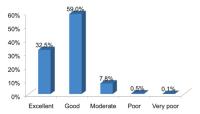 |
81 |
Safety and diagnostic efficacy of Dotarem® (gadoteric acid) for
MR mammography: Diagnosis vs. cytological findings 
Matthias Hackenbroch1, De Hua Chang1,
and David Maintz1
1Radiology, University Clinic of Cologne,
Cologne, Germany
A non-interventional post-marketing surveillance study
carried out between January 2012 and October 2013 on 1,537
patients in 15 centres showed that Dotarem® (Guerbet,
Roissy, France) is an effective contrast agent for the
identification of invasive ductal carcinomas. An MR
mammography with the diagnosis of invasive ductal carcinoma
was confirmed in 93.5% of all cases by means of a subsequent
cytological examination. Overall, a diagnosis was able to be
made in 99.2% of the cases. Adverse reactions occurred in 5
patients (0.3%). In 4 out of 5 of the patients the adverse
events were not serious and in one patient the adverse
events were serious.
|
|
3653.
 |
82 |
Influences of 3.0 Tesla MRI noise on neonates and young adults:
a longitudinal study 
Huan Li1, Chao Jin1, Jianxin Guo1,
Miaomiao Wang1, and Jian Yang1
1Department of Radiology, the First Affiliated
Hospital of Xi’an Jiaotong University, Xi'an, China,
People's Republic of
The temporary or permanent effects of strong noise from MRI
devices on hearing functions, especially for different age
populations (e.g. neonate and adult) remain unclear. Here we
conduct a longitudinal study targeting 3T MRI to disclose
such effects on hearing functions of young adults and
neonates. Results indicate that due to immaturity of hearing
nerve system, neonates show weaker sensitivity to acoustic
noise than adults. The 3T MRI noise resulted in transient
decrease of young adults’ hearing function (i.e. temporary
threshold shift), whereas showed rarely effects on neonates.
|
|
3654.
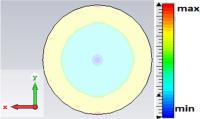 |
83 |
Robust Simulation of MRI Gradient Field-Induced Vibration of an
Implantable Medical Device 
Ihsan Zainul1, Mahdi Abbasi1,2, and
Gregor Schaefers1,3
1MR:comp GmbH, Gelsenkirchen, Germany, 2Faculty
of Engineering/ATE, Duisburg-Essen University, Duisburg,
Germany, 3MRI-STaR
GmbH, Gelsenkirchen, Germany
The interaction between the gradient induced eddy current
and the static magnetic field in the MRI system generates
force and torque to a conductive implant if the eddy current
magnetic moment and static magnetic field are misaligned. A
frequency-domain solver (F-solver) of full-wave simulator
CST studio suite 2015 was employed as an initial step to
calculate the surface current induced due to the gradient
field-induced switching.
|
|
3655.
 |
84 |
Measuring Gradient-Induced Vibration of a Conductive Device
using Laser Doppler Vibrometry at 3T 
Daniel J Martire1, Krzysztof Wawrzyn1,
William Bradfield Handler1, and Blaine A Chronik1
1Physics and Astronomy, Western University,
London, ON, Canada
In this project, a method to quantify the gradient-induced
vibration of a medical device in an MR system using a laser
Doppler vibrometer is presented. A copper annulus was
suspended in a 3T scanner, at a position chosen to maximize
the x-component of the x-gradient. The displacement of the
device was measured at different gradient field strengths.
Typical observations were understood, which should lead
towards helping establish a test standard for gradient
induced vibrations of implanted medical devices.
|
|
3656.
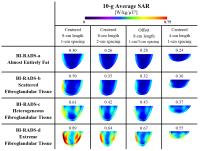 |
85 |
Effects of breast tissue density, size, and positioning on SAR
at 7T 
Joseph Vincent Rispoli1
1Weldon School of Biomedical Engineering, Purdue
University, West Lafayette, IN, United States
It is common practice to perform full-wave electromagnetic
modeling to characterize RF transmit coils and establish
safety parameters limiting power and SAR to comply with
guidelines for pre-clinical use with human volunteers.
Currently-available female voxel models are unsuitable for
simulating the filling factor of breast coils designed for
women in the prone position. Accurate breast modeling is
further confounded by variability of lipid and
fibroglandular tissues, with modeling implications owing to
disparate conductivity and permittivity values. This work
presents simulations at 7T using high-resolution,
anatomically-correct breast phantoms exhibiting varying
proportions of fatty and fibroglandular tissues, as well as
breast tissue girth, length, and positioning within the RF
coil, demonstrating the effects of these variables in
projected SAR for breast imaging.
|
|
3657.
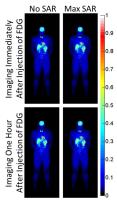 |
86 |
Potential Effects of MR-induced Temperature Increase on PET
Signal during MR/PET: Simulations of a Worst-Case Scenario 
Giuseppe Carluccio1,2, Yu-Shin Ding1,2,
Jean Logan1,2, and Christopher Michael Collins1,2
1Radiology, Center for Advanced Imaging
Innovation and Research (CAI2R), New York, NY, United
States, 2Radiology,
Bernard and Irene Schwartz Center for Biomedical Imaging,
New York, NY, United States
We explore the possibility that SAR-related temperature
increase could affect metabolic rates enough to alter FDG
signal in MR/PET. Using numerical simulations, we calculate
the distributions of SAR, temperature, metabolic rates, FDG
concentration ([FDG]), and PET signal throughout the human
body. Calculation of [FDG] utilizes a two-compartment model
considering metabolic rate through time. Results are
calculated for injection time one hour before the onset of
imaging and for injection time simultaneous with the onset
of imaging. Even for worst-case scenario (max allowable
whole-body SAR for the duration of the scan), there is
little observable effect on PET signal.
|
|
3658.
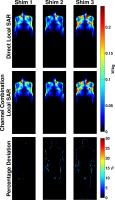 |
87 |
Local Q-matrix computation for parallel transmit MRI using
optimal channel combinations 
Arian Beqiri1, Jeffrey W Hand1, Joseph
V Hajnal1,2, and Shaihan J Malik1
1Imaging Sciences and Biomedical Engineering,
King's College London, London, United Kingdom, 2Centre
for the Developing Brain, King's College London, London,
United Kingdom
Computing 10g averaged local SAR Q-matrices for parallel
transmission MRI using self-implemented code is complex and
computationally expensive. Here we present a simple method
for computing Q-matrices using channel combinations of 10g
SAR calculated with electromagnetic field simulation
software and then simply constructed into Q-matrices from
these combinations.
|
|
3659.
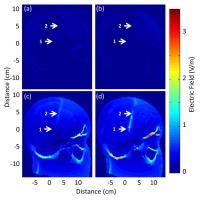 |
88 |
Heating Reduction in Unilateral And Bilateral Implanted Leads At
3T Using Parallel Radiofrequency Transmission in a Heterogeneous
Head Model 
Clare McElcheran1, Laleh Golenstani-Rad2,
and Simon Graham3
1University of Toronto, Toronto, ON, Canada, 2Massachusetts
General Hospital, Charlestown, MA, United States, 3Sunnybrook
Health Sciences Centre, Toronto, ON, Canada
Long implanted wires, such as deep brain stimulation (DBS)
implants, are subject to radiofrequency (RF) heating during
MRI. In previous work, RF shimming was used to tailor the
electric and magnetic fields creating optimal excitation and
minimal heating in a uniform cylindrical medium with a
single, straight, implanted copper wire at 3T. This work
extends the methodology to a complex, heterogeneous head
model with one or two implanted, curved copper wire(s). A
substantial improvement in both B1+-field
homogeneity and E-field reduction is achieved when compared
with a transmit/receive birdcage coil in both the single
wire and bilateral wire case.
|
|
3660.
 |
89 |
Database Construction for Local SAR Prediction: Preliminary
Assessment of the Intra and Inter Subject SAR Variability in
Pelvic Region 
Ettore Flavio Meliadň1, Alexander J.E Raaijmakers1,
Matthew C. Restivo1, Matteo Maspero1,
Peter R. Luijten1, and Cornelis A.T. van den Berg1
1Center for Image Sciences, University Medical
Center Utrecht, Utrecht, Netherlands
A reliable technique to assess the 10g averaged Specific
Absorption Rate is necessary for parallel transmit
ultra-high field body MRI. We believe that the best solution
is to build a database with many different models. We have
created nine dedicated body models and performed FDTD
simulations on them to evaluate the inter-subject
variability for prostate imaging at 7T using fractionated
dipole antennas. Maximum SAR10g ranges
from 1.64 to 2.48W/kg with 8x1W input power. No relationship
was found between BMI and maximum SAR10g.
Intra-subject variability (caused by slight antenna
positioning variability, +/-2cm) was also investigated
showing up to 67.8% SAR variability.
|
|
3661.
 |
90 |
Synthesis and SAR Assessment of Multi-slice PINS SLR RF Pulses
for Wideband MRI: A Simulation Study 
Fu-Hsing Wu1, Edzer L. Wu1, and
Jyh-Horng Chen1
1Interdisciplinary MRI/MRS Lab, Department of
Electrical Engineering, National Taiwan University, Taipei,
Taiwan
The multislice RF pulse excitation is required in some
simultaneous multi-slice (SMS) methods. The aim of this
study was to investigate the synthesis method and SAR (Specific
Absorption Rate) of multislice PINS (Power Independent of
Number of Slices) SLR RF pulses for Wideband MRI and other
SMS methods. The relative values of SAR of
the standard SLR and PINS SLR RF pulses with different
number of slices W are
presented. It can be found that the values of SAR of
PINS SLR pulses were greatly reduced compared to that of the
standard SLR pulses. For example, The SAR of
PINS SLR with W =
5 is only 38% of that of standard SLR with W =
5. And The SAR of
PINS SLR with W =
5 is only 1.9 times of that of standard SLR with W =
1.
|
|
3662.
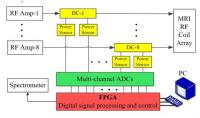 |
91 |
A Multi-Channel Real-Time Power Monitoring System for SAR
Estimation Using FPGA in High Field MRI 
Xinqiang Yan1,2, Lei Shi3, Baotong
Feng2, Zhe Wang1, Shujun Wei2,
Chuangxi Ma2, Long Wei2, and Rong Xue1
1State Key Laboratory of Brain and Cognitive
Science, Beijing MRI Center for Brain Research, Institute of
Biophysics, Chinese Academy of Sciences, Beijing, China,
People's Republic of, 2Key
Laboratory of Nuclear Radiation and Nuclear Energy
Technology, Institute of High Energy Physics, Chinese
Academy of Sciences, Beijing, China, People's Republic of, 3State
Key Laboratory of Magnetic Resonance and Atomic and
Molecular Physics, Wuhan Institute of Physics and
Mathematics, Chinese Academy of Sciences, Wuhan, China,
People's Republic of
Specific absorption rate (SAR) is a limiting factor for high
field MRI due to excess RF power deposition in human
subjects. In this study, we developed a multi-channel
real-time RF power monitoring system for global and local
SAR estimation using FPGA to ensure patient safety. The
major components of the monitoring system include multiple
dual directional couplers, demodulating logarithmic power
sensors, analog to digital converters and a FPGA fast signal
processing unit, etc. The deviation of the power measurement
was less than 0.5dB after calibration for system errors over
a dynamic RF signal range of 100dB.
|
|
3663.
 |
92 |
Local SAR increase in the human head induced by
high-permittivity pads at the sodium (23Na) resonance frequency
at 7 Tesla 
Thomas M. Fiedler1, Mark E. Ladd1,2,
and Andreas K. Bitz1
1Medical Physics in Radiology, German Cancer
Research Center (DKFZ), Heidelberg, Germany, 2Erwin
L. Hahn Institute for Magnetic Resonance Imaging, University
Duisburg-Essen, Essen, Germany
It has been shown that specific configurations of
high-permittivity pads can lead to an increase of local SAR.
So far, the effects of high-permittivity pads on RF fields
have been investigated only for 1H
imaging at 7 Tesla. For X-nuclei imaging typically
dual-tuned coils are applied. In this work, we investigate
the effect of high-permittivity pads, typically utilized to
optimize RF fields for 1H
imaging, for23Na imaging at 7T. RF simulations
were performed for two body models to determine under which
conditions SAR elevations are likely to occur or can be
avoided.
|
|
3664.
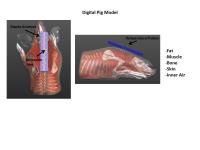 |
93 |
RF Heating Studies on Anesthetized Pigs by Using Fractionated
Dipole Antennas at 7T 
Yigitcan Eryaman1, Patrick Zhang1,
Lynn Utecht1, Russell L Lagore1, Arcan
Erturk1, Angel Torrado-Carvajal2,3,
Esra Abaci Turk3,4, Lance DelaBarre1,
Gregory J. Metzger1, and J. Thomas Vaughan1
1CMRR,Radiology, University of Minnesota,
Minneapolis, MN, United States, 2Medical
Image Analysis and Biometry Laboratory, Universidad Rey Juan
Carlos, Mostoles, Madrid, Spain, Madrid, Spain,3Madrid-MIT
M+Vision Consortium in RLE, Massachusetts Institute of
Technology, Boston, MA, United States, 4Boston
Children's Hospital, Harvard Medical School, Boston, MA,
United States
We present our results regarding electromagnetic & thermal
simulations as well as temperature measurement studies in
anesthesized pigs. Pig models were generated by segmenting
tissues from CT images. Fractionated dipole antennas were
used to deliver RF energy in the pigs body. Power levels
used for RF excitation were monitored. Temperature
measurements were made using 4 fiber optic probes at
locations which are visible in the digital pig model.
Simulation and Experiment results were compared.
|
|
3665.
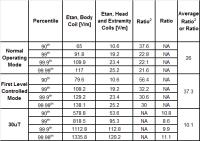 |
94 |
E-field Comparison of 1.5T Transmit Head and Extremity Coils to
1.5T Body Coils – Implications for Implantable Cardiac Pacemaker
and Defibrillator RF Heating and Unintended Stimulation 
Shiloh Sison1, Xin Huang2, Shi Feng3,
Ji Chen2, Richard Williamson3, and
Gabriel Mouchawar3
1St. Jude Medical, Sunnyvale, CA, United States, 2University
of Houston, Houston, TX, United States, 3St.
Jude Medical, Sylmar, CA, United States
E-fields tangential to implantable cardiac pacemakers and
defibrillators were analyzed at Normal and First Level
Controlled Operating Modes as well as 30uT peak B1+. 1.5T
body transmit and head and extremity transmit RF coils were
simulated. A comparison of the Etans generated by the body
transmit coils is made to those generated by head and
extremity transmit coils. If RF heating and voltage can be
shown to be safe with unrestricted body coils then no
additional analysis is necessary for head and extremity
coils since there is a 9x margin in RF heating and 3x margin
in voltage.
|
|
3666.
 |
95 |
RF safety assessment of a 7 Tesla breast coil: SAR versus tissue
temperature limits 
Thomas M. Fiedler1, Mark E. Ladd1,2,
and Andreas K. Bitz1
1Medical Physics in Radiology, German Cancer
Research Center (DKFZ), Heidelberg, Germany, 2Erwin
L. Hahn Institute for Magnetic Resonance Imaging, University
Duisburg-Essen, Essen, Germany
RF safety of Tx coils can be assessed based on SAR or
temperature limits; however, temperature is directly
correlated to tissue damage and enables a more precise RF
exposure assessment. Both safety assessments were compared
for a 7T breast coil. Temperature depends on the individual
thermoregulation system and was taken into account using
three different temperature-dependent blood perfusions.
Results for a subject with impaired thermoregulation showed
that temperature limits are exceeded by up to 6.17 °C even
when SAR limits are complied with. For a healthy subject, up
to 40% higher input power is allowed if temperature limits
are applied instead of SAR.
|
|
3667.
|
96 |
Globally Applicable MR Safety Course for Medical Students 
Steffen Sammet1 and
Christina Louise Sammet2,3
1Department of Radiology, University of Chicago
Medical Center, Chicago, IL, United States, 2Department
of Radiology, Northwestern University, Chicago, IL, United
States, 3Department
of Medical Imaging, Ann & Robert H. Lurie Children’s
Hospital of Chicago, Chicago, IL, United States
We propose an educational magnetic resonance (MR) safety
course for instructing medical students world-wide about
basic MR and patient-related safety. The MR safety course
material can be implemented as a traditional didactic or
interactive lecture in combination with hands-on safety
demonstrations and will prepare medical students for patient
screening and safety consultations when ordering MR studies.
This course can be implemented globally by various medical
school programs to ensure consistent quality of teaching
materials and MR safety standards.
|
|
















